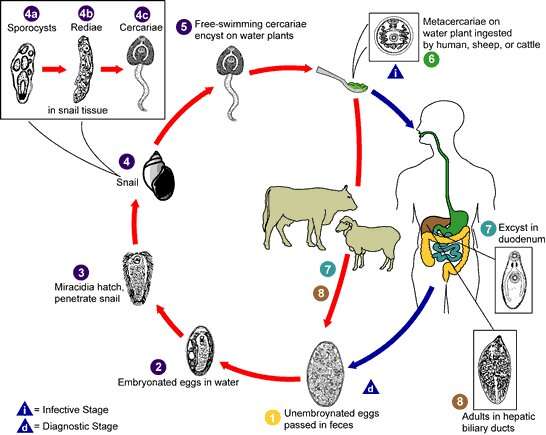Fasciola gigantica is closely related to F. hepatica. It is also a common parasite of cattle, camels, and other herbivores in Africa and of herbivores in some Pacific islands. Human infections have been reported in a number of areas of endemicity. F. gigantica is better adapted to tropical and aquatic environments. CC0 Public Domain
Fascioliasis is a parasitic disease caused by two species present in the liver: hepatic fasciola, which is prevalent worldwide, and Fasciola gigantica, which is found in Asia and Africa. The high pathogenicity of this disease has led the World Health Organisation (WHO) to include it in the list of the great diseases of humanity. The two Fasciola species cause varied clinical conditions, from cases without symptoms, to severe symptoms that can cause death. Among the severe cases, there is a broad range of neurological conditions including paralysis of limbs, motor and speech disorders, loss of senses, seizures, epilepsy and coma. Spain is the country with the second-highest number of cases of diagnosed neurological fascioliasis, after France.
In an article published in the journal Parasitology, María Adela Valero and María Dolores Bargues, professors at the Department of Pharmacy and Pharmacy Technology and Parasitology of the UV, along with professor Santiago Mas-Coma and his collaborators, show that Fasciola excretes and/or secretes a large number of proteins that induce the transformation of a plasma protein called plasminogen into the enzyme plasmin, which has the ability to decompose clots or thrombi. This transformation of plasminogen into plasmin is part of the fibrinolytic and contact systems, whose end product is a strong proinflammatory peptide called bradykinin, which increases the vasodilation of arteries and veins, as well as vascular permeability.
This is how Fasciola ends up generating the bradykinin capable of opening the hematoencephalic barrier, a small impermeable layer of cells that acts as a protector of the brain. This barrier is located in the capillaries that irrigate the brain and works as a filter between the blood and nervous systems, blocking a large number of substances from going from the blood to the brain. The opening of the hematoencephalic barrier by bradykinin makes it possible for different Fasciola secretion/excretion products to access the brain, as well as other toxic substances derived from the pathogenic action of this parasite, with the resulting neurological effects.
Santiago Mas-Coma, WHO expert in tropical diseases and study director, says, "One of the main problems that these patients with neurological symptoms have is that the medical specialists who tend to these patients rarely think of fascioliasis as the source, due to the infrequent nature of these cases. It has taken us many years of work, because nobody had any idea of the paths that a parasite present in the liver of patients could take to open the hematoencephalic barrier at a distance. There were many varied hypotheses that different teams had considered, but they had not been confirmed. Clarifying how the parasite causes these diseases and explaining all the clinical complexity and heterogeneity of these cases has undoubtedly been the most important challenge."
María Adela says, "There are problems inherent in the necessary experimental part in order to obtain the fresh biological materials to appropriately extract and analyze the excretion/secretion proteins in a parasite of vectoral transmission by way of a freshwater snail, and the subsequent experimental infection of laboratory animals. They are lengthy experiments where many aspects can go wrong. Fortunately, we had the expected success."
More information: J. González-Miguel et al. Numerous Fasciola plasminogen-binding proteins may underlie blood-brain barrier leakage and explain neurological disorder complexity and heterogeneity in the acute and chronic phases of human fascioliasis, Parasitology (2018). DOI: 10.1017/S0031182018001464
Journal information: Parasitology
Provided by Asociacion RUVID























